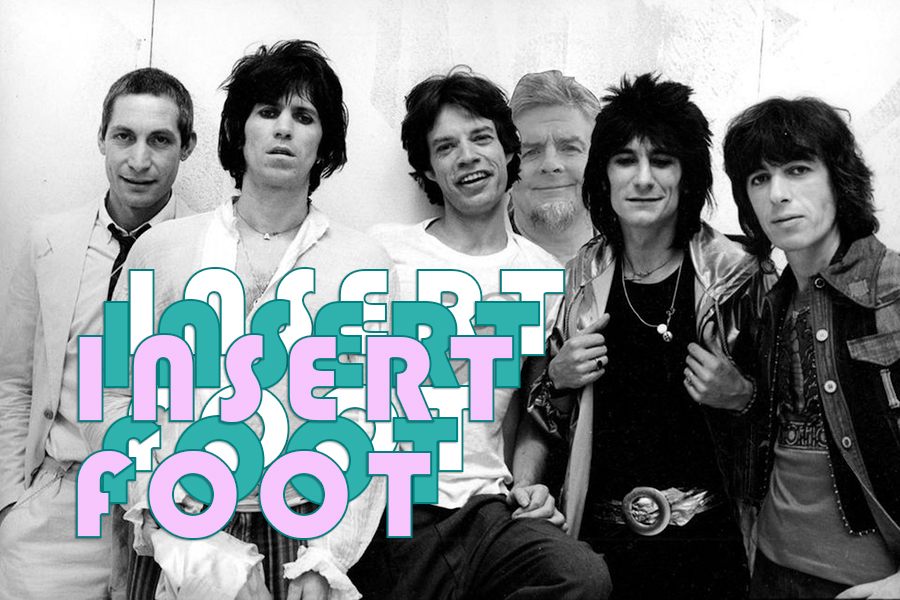Insert Foot: Rock books and dying dreams of COVID-19 lockdown

Insert Foot ignoring reality by doing some light reading.
You want hope that 2020 will work itself out anytime soon?
Sorry. This is where your dreams come to die today.
Here’s how optimistic I am the virus-soaked coast will clear to emerge from our dark corner/mother’s basement/fire shelter made of aluminum foil and duct tape anytime soon: I just started reading Stephen King’s “The Stand.”
I’ve never read Stephen King. It’s something like 118,000 pages about a virus burning society into a twisted, vicious, unrecognizable chunk of planet. I’m about 200 pages into what seems like a longer commitment than most marriages. Because I don’t believe I’m ever leaving the house again without a spacesuit.
This thing is dreary. And I’m a fan of Cormac McCarthy, whose stories I can handle every couple years as long as I commit to therapy afterward. And I still think my new anvil-sized book is dreary. I’m committed, because … why not? There’s nothing better to do. And it’s pretty well-written and keeps my attention.
It’s actually 1,100-and-something pages. The last book I read this physically heavy was a God-awful Tom Clancy book I ingested during a sadistically bad time in my life, where I paid the penance of absorbing Clancy’s unnecessary 17-page explanation of how a nuclear bomb works. I’ve had a better time watching concrete dry. Yet it was a challenge I couldn’t pass up.
I can’t imagine why I don’t get many dates.
The original point here was to talk about music books. Since we can’t really experience live shows, I thought it might be fun to read about the good old days when you didn’t need to wrap yourself in an acre of plastic sheeting before entering a venue. Here are five books for fans needing to remember what the magic of music is all about (looks over at bookshelf, remembers …):
“Here, There and Everywhere: My Life Recording the Music of The Beatles,” by Geoff Emerick. The Beatles’ engineer does an exceptional job of showing just how the Beatles really changed everything, not only about the content of popular music, but how it forced producers to adjust on the fly to keep up with those Beatle brains. The inside stories are fascinating and told with respect, even if it is pretty clear who his favorite Beatle was (hint: he wasn’t really dead). I’ve read a ton of Beatles’ books and this is easily my favorite.
“Wilco: Learning How to Die,” by Greg Kot. The longtime music critic of the Chicago Tribune brilliantly captures one of the most inspiring and fascinating bands of this century, Wilco, during the most important time in its history. It’s one of those books that makes rock journalists plot to kill each other out of jealousy (which I think I told Kot one year at SXSW after one or two … or 10, drinks).
“Scar Tissue,” by Anthony Kiedis. The Red Hot Chili Peppers were once a groundbreaking and semi-complicated band, which you’d never know by the public persona. The band’s frontman leaves his ego mostly behind, painting a picture so honest that it occasionally requires a double take. Like the music in the band’s glory days, Kiedis gets to the point and doesn’t do what so many rock stars do in telling their own stories: linger way too long on what they think makes them look good. It’s still refreshing.
“Old Gods Almost Dead: The 40-Year Odyssey of The Rolling Stones,” by Stephen Davis. Remarkably, it feels comprehensive, even while leaving out the last third of the Stones’ career. Davis is more famous for writing “Hammer of the Gods” about Led Zeppelin and Seattle mud sharks, but I choose this instead. It’s a well-done, balanced piece of journalism that entails most of the band’s history without pushing too hard one way or another.
“Running with Monsters,” by Bob Forrest. The man made famous as Dr. Drew’s hat-wearing, bespectacled sidekick on reality television became such an expert on addiction because he was an addict, running loose in Hollywood as the frontman of Thelonious Monster during the ’80s and ’90s. Forrest was a talented underachiever and lived to tell about watching so many friends conquer the charts while he bounced in and out of rehab. Nobody tells stories like Forrest, and thankfully he didn’t die (and still hasn’t, last I checked) before he could put most of them on paper. Not coincidentally, 2011 documentary “Bob and the Monster” is just as good.
Try to have a good week.
Follow music critic Tony Hicks at Twitter.com/TonyBaloney1967.
